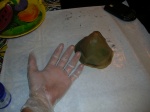Copper benzoate[]
Formula: Cu(C6H5COO)2
Description:[]
Copper benzoate is a fuel which is used in some blue color compositions. It is not used very often as it is more expensive than most alternatives. The use of copper benzoate as a fuel in the two component blue star formula with ammonium perchlorate was first published by David Bleser in American Fireworks News circa 1990.
Hazards: []
Copper benzoate is poisonous and should be handled wearing a dust mask
Sources:[]
Some specialised chemical vendors supply the material. Alternatively it can be manufactured without great difficulty via two different routes. In one, Benzoic acid and Copper carbonate are boiled in water until the reaction is complete. In the the other route, described in the following synthesis tutorial, the material is obtained from a solution of sodium or potassium benzoate and a soluble copper salt. When these solutions are added together a green precipitate of copper benzoate forms. This is filtered, thoroughly rinsed with hot water and left to dry.
Synthesis[]
Materials[]
- Potassium Benzoate
- Copper sulfate
- 500ml or larger reaction vessel
- 100ml reaction vessel
- 500ml or larger filtrate reception vessel
- large polypropylene or HDPE funnel
- Filter paper
- Distilled water
- Dessication vessel
- Stirring implement
Reaction procedure[]
For this procedure you will require a copper salt (for my tutorial we will be using Copper Sulphate) and a benzoate salt, of which I will be using Potassium because of it's availability to me, and the less rigorous purification needed in comparison to the Sodium salt to obtain a good colour in flames.
The measurements are as thus:

CuSO4x5H2O + 2 K(C6H5COO) → Cu(C6H5COO)2 + K2SO4 + 5H2O
| Copper Sulphate | 249.7 g/mol |
| Potassium Benzoate | 320,4 g/mol |
Or very roughly
| Copper Sulphate | 25 |
| Potassium Benzoate | 32 |

Dissolve the Benzoate salt into warm water into the larger reaction vessel (Potassium Benzoate dissolves 65 grams in 100 grams of DISTILLED water {1 milliliter of water is one gram} @ 20°C) while at the same time dissolving the copper salt into warm water into the smaller reaction vessel (31.6 g/100 g (0 °C)). There must be no solids left in the solution.

Pour the copper salt solution slowly into the solution of the Benzoate salt while stirring vigourously, when the addition is complete continue stirring for 10 minutes and let sit for 2 hours. You should now have a solution of Potassium sulfate with a fine precipitate of nearly insoluble copper benzoate.
Optional step, Heat slowly on a hot plate at low temperature to dissolve byproducts to shorten filtration,

Separation of Compounds[]
At this time you should have already put on your gloves (latex is acceptable for this as there are no strong acids or bases involved), Prepare your filter and place in filtration vessel. Slowly pour small amounts of the heterogeneous solution of Copper Benzoate and potassium sulfate into the funnel and allow to filter through for several minutes for each addition. You will see Potassium sulfate recrystallize in the filtration vessel if you used the minimal amount of water necessary to dissolve the reactants. You may at any time after the first course of filtration remove this to a freezer to force crystallize and filter for a high temperature oxidizer.

Wash the benzoate several times with distilled water while still in the filter and allow to drain as completely as possible,when fully drained you must CAREFULLY squeeze it in the filter to push the water out! this is crucial to keeping drying time to a minimum, without this step it may take days!
This picture is what it looks like if you do not squeeze the water out. Copper benzoate is a very fluffy easily airborne material when dry. If not squeezed out it will trap the water inside.

Empty the filtrate into your dessication vessel and leave in a cool dry place until fully dry.
Alternatively you may empty it into a shallow dish and place that into a larger vessel on a bed of CaCl2 chips for several days... this is the method I used and most certainly works faster.
References[]
http://www.wfvisser.dds.nl/EN/cheminfo_EN.html http://www.youtube.com/watch?v=0RHMCltqSJc